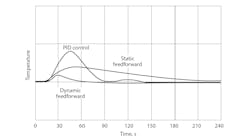Expanding advanced process control to secondary units
It’s no secret that advanced process control (APC) has played a major role in the process industries for many decades. However, while many organizations focus only on major process units, there’s often an untapped opportunity to do more, and expand their APC footprint to secondary units and networks. from increasing margins to operational excellence. The benefits of this are significant.
Also, not just one or two opportunities are available. Rather, there’s a variety of ways to implement APC applications on secondary units, such as controls for environmental emissions, fuel gas network, sulphur complex, steam networks, H2 networks and more. So why aren’t more organizations taking advantage and choosing to expand their APC footprint? While some report a shortage of APC resources and gaps in APC technology among other reasons, one main issue is not understanding achievable benefits. As a result, they don’t expand their APC footprint and leave benefits on the table.
Understanding APC for secondary units
Among the difficult control problems APC can address in typical refineries and petrochemical plants is managing fuel oil (FO) and fuel gas (FG) combusted in furnaces or boilers. Analyzers are available at furnace level (typically O2 and CO), while others are available at stack level (typically SOx and NOx) with multiple furnaces sending flue gas to the same stack. Ideally, facilities would have a system measuring environmental limits in the furnace and stack level, but even in that case, due to local, regional and national regulations, the process for respecting these limits can be extremely complicated.
As a result, operators typically only control real-time measures, taking a huge safety margin compared to what APC can do. APCs have been successfully designed and commissioned as part of a wider scope to address the emissions problem of limiting plant load for major units like crude columns or ethylene crackers. Moreover, controlling environmental limits (not just monitoring them) in closed-loop gives an advantage in managing environmental constraints and regulations. By not using APC, organizations sacrifice potentially millions of dollars per year.
Fuel gas network stabilization
[pullquote]Fuel gas network control is another problem that refineries and petrochemical plants must handle. Today, it’s common to see sites with unstable fuel gas networks that become a major issue, impacting operations and the site’s energy costs. However, with APC, these sites can benefit from a stabilized fuel gas network and optimized energy management that helps them achieve results. For example, organizations with APC can:
- Reduce variability in the refinery fuel gas system;
- Simultaneously stabilize pressure and calorific values;
- Stabilize furnace operations;
- Stabilize process unit operations;
- Minimize overall fuels costs;
- Typically maximize use of fuel oil;
- Minimize use of enrichment gas (LPG/propane/butane/CH4) when possible;
- Respect furnace/stack environmental limits while making money;
- Perform closed-loop emissions control, not just emissions monitoring;
- Minimize fuel costs until the process unit’s constraints or emissions limits become active;
- Help other APCs maximize throughput and overall profit;
- Consistently push local and overall constraints, taking the benefit of a more stable fuel gas network;
- Minimize/eliminate routine flaring;
- Minimize blowdown gas recovery compressor consumption;
- Reduce the energy intensity index (EII); and
- Improve furnace efficiency with more stable firing, enabling further reduction in excess air.
With proper knowledge and APC, refineries and petrochemical plants can simultaneously stabilize fuel gas pressure and quality, and address the inherent strong nonlinearities in the system. In one example, fuel gas header pressure control in a small 90-KBPD refinery gave an audited cost reduction of more than $2.1 million per year.
[javascriptSnippet]
Sulphur complex assistance
Sulphur complexes include multiple lines and equipment, and are another important part of refineries that APC can assist. Any upsets in a sulphur complex can be costly for the refinery and the environment. This is where APC applications can provide benefits.
For example, while best-in-class refiners can maintain around a 10-15 °C dew point margin, it’s not uncommon to see sites with greater than 35 °C margins. This is a large margin with heavy costs due to reduced conversion and increased consumption. Not to mention, some refineries are also sulphur-limited, which costs millions of dollars per year. To address these issues, companies need to build first-principle dew point inferentials, but this is not an easy task because sulphur condenses in catalyst pores and a capillarity condensation effect occurs. The dew point limit is a function of many variables that affect partial pressure of sulphur in a vapor phase over the catalyst, and consequently, related saturation temperature that’s already been reduced by the presence of inert gases (N2, H2O, not-reacted H2S, etc.). The accurate first-principles dew point inferential can be built, but it requires appropriate competence and integration of APC and kinetic modeling technologies.
While achievable benefits can vary depending on layout and constraints distribution, benefits are typically between $800,000 and $1.1 million per year for a small 100-KBPD refinery. This doesn’t include sulphur-limited refineries, where benefits can be millions of dollars per year.
Steam network benefits
Finally, a steam network can be complex with multiple pressure headers, but APC can give benefits there, too. These include:
- Improved steam header pressure control by manipulating boilers, turbines and let-downs to stabilize operations and maintain required steam production levels;
- Minimized downgrading of steam through let-down valves, mainly by manipulating turbine loads, extractions and boiler loads;
- Minimized vent flows by manipulating turbine loads and extractions and boiler loads;
- Control of all constraints, including emission limits during the transition, while optimizing boiler load changes; and
- Optimized boiler and gas turbine loads, maximizing the most efficient machine utilization as defined by a higher-level, closed-loop, rigorous optimizer.
APC applications need to cover the all-steam production side and meet steam demand. For example, they addressed issues with a high-pressure (HP) steam let-down valve and flow of more than 10 t/h of HP steam downgraded during normal operations. Benefits achieved by APC on this steam network were more than $1.5 million per year, counting only those due to reduced let-down flows and vent flows.
A more comprehensive and efficient solution can be built where a model-based optimizer drives the APC system based on overall economics and efficiencies. In a simple case, an optimizer suggests swapping the load between two boilers to save about $3,000 per day (Figure 1). Many opportunities like this example exist in steam networks.
[sidebar id =1]
Achieving best performance with APC
While there are other ways to update secondary units, these are a few examples of how APC can be implemented and utilized in an organization. To achieve best performance in margins and operations, organizations must expand their APC footprint to secondary units. Organizations often don’t fully understand the benefits available to them and/or lack engineering resources to capture APC benefits from secondary units. APC engineers also often have significant workloads maintaining applications due to using traditional APC technology. Advances in APC software like adaptive process control empowers end users, automates many tasks, adapts and calibrates models in the background with no disruption to operations, and provides increased robustness. All of this can help reduce the APC maintenance workload and maintain peak APC performance. Advances in APC technology can enable organizations to shift focus from just maintaining existing APC applications to deploying additional APC applications, capturing benefits from secondary units, and enabling a best-in-class APC program.
[sidebar id =2]
Latest from Multivariable Control

Leaders relevant to this article:


